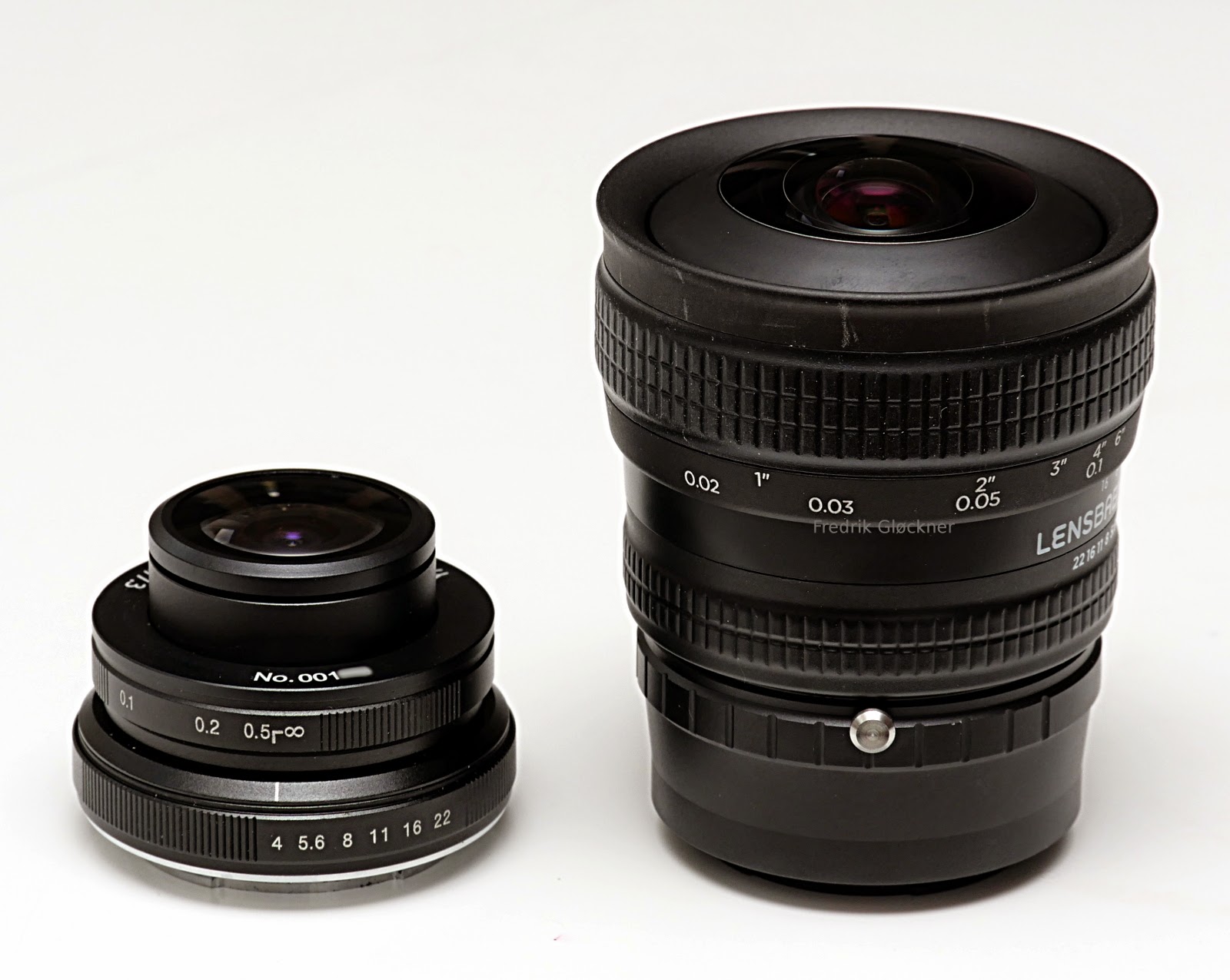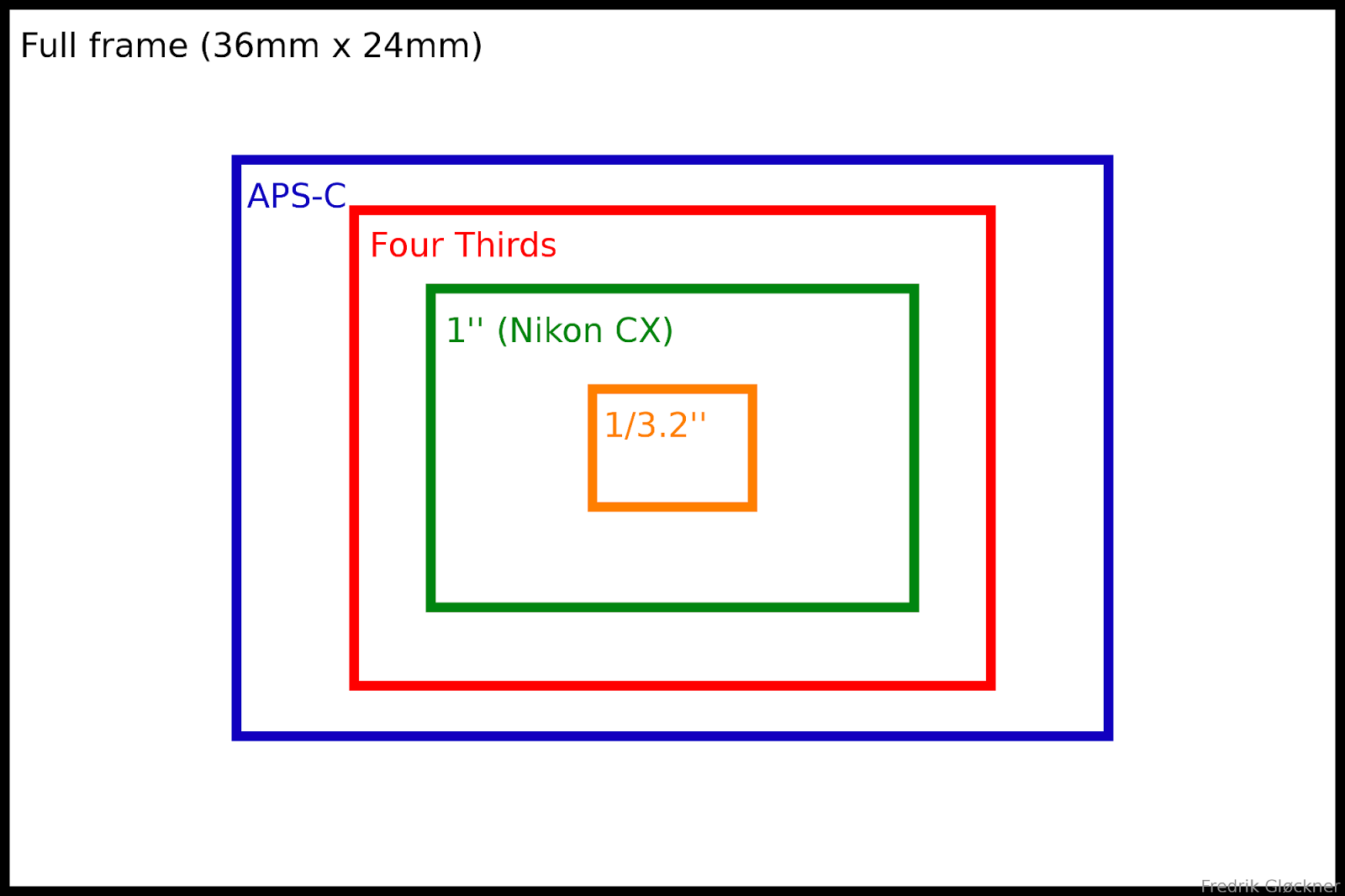There is a new, expotic, and reasonanbly priced lens available, the Lensbaby 5.8mm f/3.5 circular fisheye. It was announced in April for DSLR mounts like Nikon F and Canon EF. In November, it was further announced in Micro Four Thirds mount and Sony E mount.
So, should you buy this lens, and if so, in what mount? That's what I will be trying to answer in this article.
To help the review of the lens, I will be comparing it with a similar lens for Sony E mount, the Yasuhara Madoka 180 7.3mm f/4 (my review). Both lenses are shown below:
Left: Yasuhara Madoka 180 7.3mm f/4 circular fisheye lens. On the right, is the Lensbaby 5.8mm f/3.5 with an adapter for Sony E-mount.
Introduction
This blog is a user's perspective on the Micro Four Thirds camera system. Read more ...
Lens Buyer's Guide. Panasonic GH4 review.
My lens reviews: Olympus 9mm f/8 fisheye, Lumix G 12-32mm f/3.5-5.6, Leica 25mm f/1.4, Lumix X 12-35mm f/2.8, Lumix X 35-100mm f/2.8, Sigma 30mm f/2.8, Sigma 19mm f/2.8, Lumix X PZ 14-42mm f/3.5-5.6, Lumix X PZ 45-175mm f/4-5.6, Olympus M.Zuiko 45mm f/1.8, Panasonic Lumix G 100-300mm f/4-5.6, Panasonic Leica Lumix DG Macro-Elmarit 45mm f/2.8 1:1 Macro, Panasonic Lumix G 45-200mm f/4-5.6, Panasonic Lumix G 20mm f/1.7 pancake, Panasonic Lumix G 14mm f/2.5 pancake, Panasonic Lumix G HD 14-140mm f/4-5.8, Panasonic Lumix G HD 14-140mm f/3.5-5.6, Panasonic Lumix G 8mm f/3.5 fisheye, Lumix G 7-14mm f/4, Samyang 7.5mm f/3.5 fisheye, Tokina 300mm f/6.3 mirror reflex tele, Lensbaby 5.8mm f/3.5 circular fisheye lens
The blog contains affiliate links. As an Amazon Associate I earn from qualifying purchases.
Lens Buyer's Guide. Panasonic GH4 review.
My lens reviews: Olympus 9mm f/8 fisheye, Lumix G 12-32mm f/3.5-5.6, Leica 25mm f/1.4, Lumix X 12-35mm f/2.8, Lumix X 35-100mm f/2.8, Sigma 30mm f/2.8, Sigma 19mm f/2.8, Lumix X PZ 14-42mm f/3.5-5.6, Lumix X PZ 45-175mm f/4-5.6, Olympus M.Zuiko 45mm f/1.8, Panasonic Lumix G 100-300mm f/4-5.6, Panasonic Leica Lumix DG Macro-Elmarit 45mm f/2.8 1:1 Macro, Panasonic Lumix G 45-200mm f/4-5.6, Panasonic Lumix G 20mm f/1.7 pancake, Panasonic Lumix G 14mm f/2.5 pancake, Panasonic Lumix G HD 14-140mm f/4-5.8, Panasonic Lumix G HD 14-140mm f/3.5-5.6, Panasonic Lumix G 8mm f/3.5 fisheye, Lumix G 7-14mm f/4, Samyang 7.5mm f/3.5 fisheye, Tokina 300mm f/6.3 mirror reflex tele, Lensbaby 5.8mm f/3.5 circular fisheye lens
The blog contains affiliate links. As an Amazon Associate I earn from qualifying purchases.
Tuesday 30 December 2014
Friday 26 December 2014
A decade of affordable digital system cameras
In August 2003, Canon launched the EOS 300D. It was not the first digital SLR camera. Both Canon and Nikon had models preceding it. But it was the first truly affordable DSLR camera. Still a lot more expensive than a similar camera today, but it was sold at a price that most enthusiasts could justify.
Prior to this launch, people interested in photography would typically still use film based SLRs, or digital cameras without interchangeable lenses. So it is fair to say that the camera started a big change in the camera market: Affordable digital system cameras. Here is a look at what has happened over the last decade.
Prior to this launch, people interested in photography would typically still use film based SLRs, or digital cameras without interchangeable lenses. So it is fair to say that the camera started a big change in the camera market: Affordable digital system cameras. Here is a look at what has happened over the last decade.
Wednesday 24 December 2014
Mirrorless cameras: Smaller wide angle lenses
Compared with DSLR cameras, mirrorless cameras have lost the mirror, obviously. This makes the construction simpler, but there is also a more important factor: It allows putting the lens mount closer to the imaging sensor, giving a shorter register distance.
A shorter register distance means that wide angle lenses can be constructed simpler. With a long register distance, typically for a DSLR camera, you need a complicated retrofocal optical design to make wide angle lenses. With a shorter distance, the lens design becomes simpler, and you can make smaller, lighter, and less expensive wide angle lenses.
Here is a good example. On the left, there is the Yasuhara Madoka 180 7.3mm f/4 (my review), designed for the Sony E-mount mirrorless system. On the right, is the Lensbaby 5.8mm f/3.5 with an adapter for Sony E-mount. Both are circular fisheye lenses for the APS-C sensor size. But the lens on the right is designed for use on DSLR cameras, with a longer register distance.
Beyond being designed for mirrorless and DSLR, respectively, the lenses are a bit different. The Lensbaby covers a slightly wider field of view, and has a marginally larger maximum aperture. The Yasuhara lens is more distorted in the edges, and has the better optical performance. But by and large, the lenses do the same thing. And there is a huge difference in the size. Which lens would you rather bring along?
A shorter register distance means that wide angle lenses can be constructed simpler. With a long register distance, typically for a DSLR camera, you need a complicated retrofocal optical design to make wide angle lenses. With a shorter distance, the lens design becomes simpler, and you can make smaller, lighter, and less expensive wide angle lenses.
Here is a good example. On the left, there is the Yasuhara Madoka 180 7.3mm f/4 (my review), designed for the Sony E-mount mirrorless system. On the right, is the Lensbaby 5.8mm f/3.5 with an adapter for Sony E-mount. Both are circular fisheye lenses for the APS-C sensor size. But the lens on the right is designed for use on DSLR cameras, with a longer register distance.
Beyond being designed for mirrorless and DSLR, respectively, the lenses are a bit different. The Lensbaby covers a slightly wider field of view, and has a marginally larger maximum aperture. The Yasuhara lens is more distorted in the edges, and has the better optical performance. But by and large, the lenses do the same thing. And there is a huge difference in the size. Which lens would you rather bring along?
Tuesday 16 December 2014
Bokeh part 3
In part 1, I discussed what bokeh is (the nature of out of focus rendering). I also illustrated that the larger the aperture, the more selective focus. In part 2, I compared the bokeh between some different lenses.
Here, I am going to illustrate how the sensor size affects the degree of selective focus. Some would say "the amount of bokeh", but that is the wrong use of the term. I'll stick to the correct nomenclature in this article, to avoid angering people.
First off, here is a comparison of common sensor sizes:
The full frame sensor size is derived from the common 135 film format, commonly used in SLR and compact cameras. At this time, there is only one mirrorless camera system which uses a full frame sensor, the Sony A7 series. You'll also find full frame sensors in Nikon D810 and Canon 5D III DSLR cameras, to name a couple.
Here, I am going to illustrate how the sensor size affects the degree of selective focus. Some would say "the amount of bokeh", but that is the wrong use of the term. I'll stick to the correct nomenclature in this article, to avoid angering people.
First off, here is a comparison of common sensor sizes:
The full frame sensor size is derived from the common 135 film format, commonly used in SLR and compact cameras. At this time, there is only one mirrorless camera system which uses a full frame sensor, the Sony A7 series. You'll also find full frame sensors in Nikon D810 and Canon 5D III DSLR cameras, to name a couple.
Saturday 13 December 2014
Old bag, new bag
Camera bags are very personal things. A bag that works well for me, might be totally wrong for someone else.
For the last seven years, I have used the Tamrac Velocity 6x sling bag. I have used it extensively, so much that I needed to replace it with a new bag. And what better bag to buy than exactly the same model? Here they are, the new to the left, and the old to the right:
For the last seven years, I have used the Tamrac Velocity 6x sling bag. I have used it extensively, so much that I needed to replace it with a new bag. And what better bag to buy than exactly the same model? Here they are, the new to the left, and the old to the right:
Tuesday 9 December 2014
Is metal better?
The last years, there has been a clear trend within consumer electronics: The devices must have a smooth metal surface. This is perceived as a mark of quality: Metal means solidity for the general public.
One example is the Lumix G 12-32mm f/3.5-5.6 (my review) pancake zoom lens, seen below (to the left) compared with the older Lumix X PZ 14-42mm f/3.5-5.6 (my review):
The older black lens has a plastic body, while the newer silver lens has a bare metal surface.
One example is the Lumix G 12-32mm f/3.5-5.6 (my review) pancake zoom lens, seen below (to the left) compared with the older Lumix X PZ 14-42mm f/3.5-5.6 (my review):
Lumix G 12-32mm f/3.5-5.6 (left), Lumix X PZ 14-42mm f/3.5-5.6 (right)
The older black lens has a plastic body, while the newer silver lens has a bare metal surface.
Subscribe to:
Posts (Atom)



